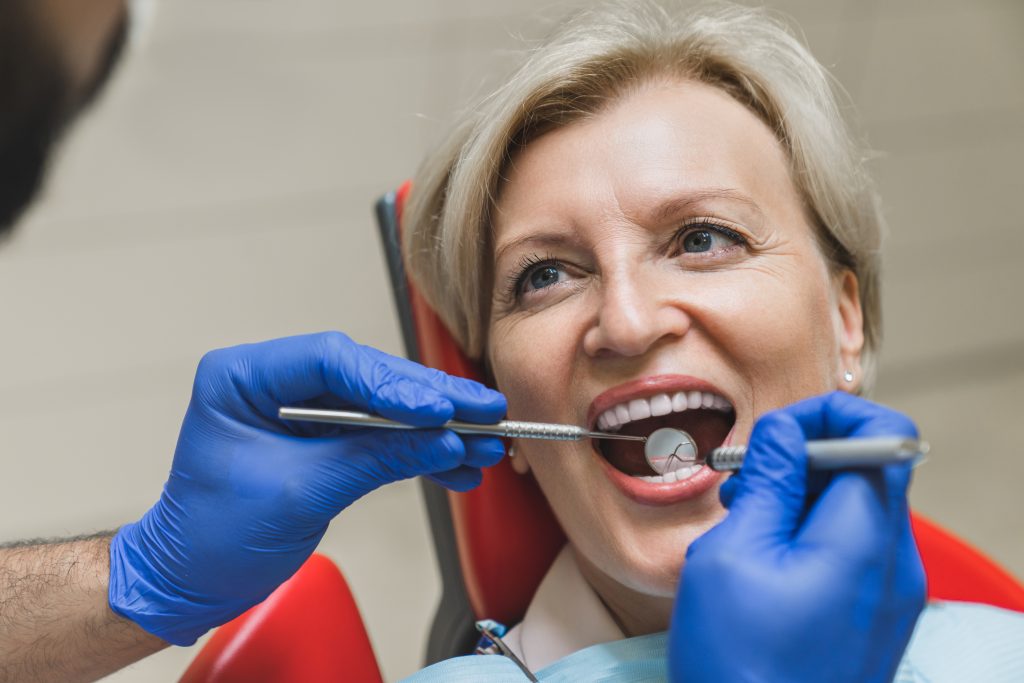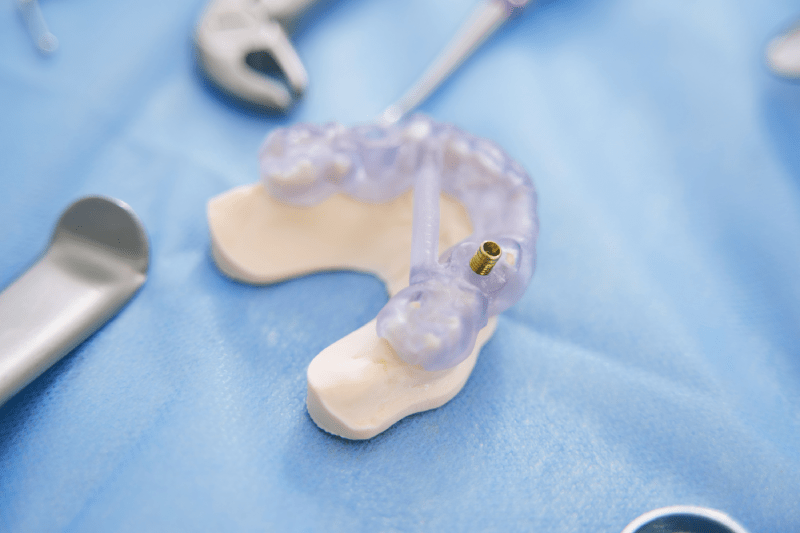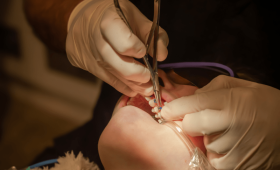What is a Dental Veneer and How is it Applied?
A dental veneer is a thin, specially designed layer made of porcelain or composite materials that is bonded to the front surface of teeth. Porcelain veneers are used to aesthetically correct discoloration, shape and size imperfections, small fractures, and gaps in teeth. The application process is minimally invasive; a very small amount of the tooth surface is abraded, or sometimes they can be bonded directly without any abrasion. This preserves the natural tooth structure to the maximum extent while giving the person the smile of their dreams. Veneers can be applied from a single tooth to the entire mouth.
How Much Are Dental Veneers in Istanbul?
The prices of dental veneers in Istanbul vary greatly depending on the chosen material, the number of teeth to be treated, the location of the clinic, and the doctor’s experience. Prices are usually determined on a “per tooth” basis, and the quality of the material used (for example, E.max porcelain or zirconium) directly affects the cost. While starting prices can give a general idea, a detailed examination and a personalized treatment plan are essential to get a definitive price. In addition, some clinics may offer package prices that include extra services such as accommodation and transfers.
What Are the Main Factors Affecting Prices?
The main factors affecting dental veneer prices include material selection (porcelain, composite, zirconium), the expertise of the dentist and clinic, the quality of the technological equipment used, and the laboratory quality. Porcelain veneers are more expensive than composite veneers because they offer a more durable and aesthetic result. Whether additional procedures (such as teeth whitening, fillings, or root canal treatment) are needed before the treatment is also an important factor that affects the total cost.
What is the Difference Between a Zirconium Veneer and a Porcelain Laminate?
A zirconium veneer is a material typically designed to cover the entire tooth and is known for its high durability. A porcelain laminate, on the other hand, is a much thinner veneer that is bonded only to the front surface of the tooth. Laminates require less intervention on the natural tooth and provide a natural appearance due to their light-transmitting properties. While zirconium is preferred more for back teeth where chewing forces are intense or for bridge work, a laminate is ideal for front teeth where aesthetic concerns are high.
How Long Does the Dental Veneer Procedure Take?
The dental veneer procedure is generally completed in 2 to 3 sessions. In the first session, the teeth are prepared and impressions are taken. This stage can take a few hours, depending on the number of teeth. In the second session, the veneers prepared in the laboratory are tried on. If the patient and the doctor are satisfied with the appearance of the veneers, they are permanently bonded in the third session. The entire process can be completed within an average of 5 to 7 days in total.
Is Getting a Dental Veneer a Painful Procedure?
No, the dental veneer procedure is generally a painless process. Since the teeth are numbed during the procedure, patients do not feel any pain or discomfort. The only thing felt during the preparation of the teeth might be a vibration. It is normal to experience a slight sensitivity for the first few days after the procedure, but this can usually be managed with painkillers and disappears in a short time.
What is the Lifespan of Dental Veneers?
The lifespan of dental veneers varies depending on the quality of the material used, the patient’s oral hygiene, and chewing habits. Well-cared-for porcelain laminates can be used without any problems for 10 to 15 years or even longer. Regular brushing, flossing, and periodic dental check-ups are of vital importance to extend the lifespan of the veneers. Avoiding biting hard-shelled foods also prevents damage to the veneers.
What is the Difference Between a Porcelain Laminate and a Laminate Veneer?
Porcelain laminate and laminate veneer are essentially the same terms. Both refer to porcelain veneers that are applied only to the front surface of the teeth and require minimal abrasion. They are also known as “leaf porcelain” in common parlance. This treatment is an ideal option for people who are not satisfied with the color, shape, or size of their teeth but want to preserve their healthy tooth structure.
How Should Nutrition Be After Getting Veneers?
After the dental veneers are bonded, it is recommended to eat soft and non-sticky foods for the first few days. This allows the adhesive to fully harden. You can then return to a normal diet. However, it is important to avoid biting very hard foods like nuts or ice to prevent the veneers from breaking. Veneers function like natural teeth, and with proper care, all kinds of food can be chewed comfortably.

Do Dental Veneers Look Natural Aesthetically?
Yes, modern porcelain laminates are produced to be able to mimic the light transmission of natural teeth. In this way, they give a lively and natural appearance to the teeth they are applied to. The dentist specially designs the veneers to suit the patient’s facial structure, lip line, and the color of their other teeth. This personalization process prevents the veneers from looking artificial and creates a natural smile aesthetic.
How Are Dental Veneers Cleaned and Cared For?
The care of dental veneers is the same as for natural teeth. You should brush your teeth at least twice a day and use dental floss. It is important to pay attention to brushing techniques to prevent plaque buildup at the joint areas of the veneers. In addition, water flossers are also an effective tool for cleaning veneers and gums. Not missing routine dental check-ups is very important for early diagnosis of potential problems.
Do Dental Veneers Prevent Tooth Decay?
No, dental veneers do not prevent tooth decay. Cavities can continue to form on the teeth that have veneers applied, especially in the edge areas where the veneer meets the tooth. Therefore, it is essential to maintain a regular and meticulous oral hygiene routine to protect the health of the teeth under the veneers. Even though the veneer covers the front surface of the tooth, its back surface and interdental spaces are still prone to decay.
Who Should Get Dental Veneers?
Dental veneer treatment is suitable for people who have discoloration, shape or size imperfections, gaps between their teeth, small fractures, or cracks, but who have a healthy tooth structure. Different treatments (for example, crowns) may be more suitable for individuals with severe wear, large fillings, or severe crowding on their teeth.
Is the Dental Veneer Procedure Reversible?
The dental veneer procedure is an irreversible one because even a minimal abrasion is performed on the tooth surface. When the veneers are removed, the enamel layer, which is the protective layer of the underlying tooth, has been abraded, so the tooth cannot be left without a veneer. Therefore, it is important to discuss all options and your expectations in detail with your dentist before deciding on the treatment.
What Happens if a Dental Veneer Breaks?
Dental veneers can break if they are subjected to an excessive hard impact due to the natural brittleness of porcelain. If a veneer breaks, it usually cannot be repaired and must be replaced with a new one. Therefore, it is very important to avoid biting on hard-shelled foods, biting your nails, or chewing on a pen to protect your veneers.
What is the Difference Between a Porcelain Laminate and a Composite Veneer?
Porcelain laminate and composite veneer differ in both material and application method. Composite veneers are shaped directly onto the tooth by the dentist, while porcelain laminates are prepared in a laboratory. Porcelain laminates are more durable, more resistant to staining, and last longer. Composites, on the other hand, are more affordable and can be completed in a single session, but their color can change over time.
Do Dental Veneers Change Color?
Porcelain laminates are highly resistant to staining because their surfaces are extremely smooth and impermeable. Even substances with a high potential for staining like coffee, tea, and cigarettes do not permanently change the color of the porcelain. This is one of the biggest aesthetic advantages of dental veneers.
What is the Relationship Between a Smile Makeover and Dental Veneers?
Dental veneers are one of the most important components of a smile makeover treatment. A smile makeover aims to create a personalized smile aesthetic by considering factors such as the patient’s facial structure, lip line, the condition of the gums, and the shape of the other teeth. Dental veneers form the basis of this design by making the shape, size, and color of the teeth ideal.
Do Dental Veneers Harm the Gums?
When properly applied and in good harmony with the gums, dental veneers do not harm the gums. Finishing the edges of the veneer correctly at the gum line prevents plaque buildup and the resulting gum inflammation. Thanks to biocompatible materials, the gums integrate with the veneers in a healthy way.
Are Temporary Teeth Placed During the Dental Veneer Procedure?
Yes, during the preparation stage of the dental veneers, temporary teeth are placed to prevent tooth sensitivity and meet the aesthetic needs of the patients. These temporary teeth allow the patient to comfortably continue their social life until the permanent veneers arrive from the laboratory.

Can a Full-Mouth Dental Veneer Treatment Be Applied?
Yes, a full-mouth dental veneer treatment can be applied. This is the process of applying veneers to the front surfaces of all teeth. It is an ideal solution, especially for patients who have color, shape, and alignment problems with all of their teeth. With a full-mouth veneer, a perfect aesthetic and functional smile can be achieved.
Do Dental Veneers Affect Speech?
Dental veneers do not negatively affect speech. On the contrary, they can help some sounds to come out more clearly by correcting gaps between teeth or shape imperfections. A short adaptation period may be required for the tongue to get used to the new structure in the first few days, but this corrects itself quickly.
Can Smokers Get Dental Veneers?
Yes, smokers can get dental veneers. However, smoking can cause staining on the natural teeth and gums around the edges of the veneers. In addition, the negative effect of smoking on gum health poses a risk to the longevity of the veneers. Quitting smoking is the most ideal for increasing the success of the treatment.
How Should a Clinic Be Chosen in Istanbul?
When choosing a clinic for dental veneer treatment in Istanbul, it is important to pay attention to the doctor’s expertise and experience, the clinic’s international accreditations, the quality of the materials used, and patient reviews. By doing thorough research, you can choose a clinic that is transparent and reliable and is run by an experienced team.
How Does the Process Work for Foreign Patients?
For foreign patients, the process usually begins with an online consultation. The patient sends photos and X-rays of their teeth to the clinic. The dentist prepares a treatment plan and an estimated cost based on this information. When the patient arrives in Istanbul, all appointments are scheduled in advance, so the process is completed quickly, and the patient can usually return to their country with their new smile within 1 week.
How Fast Does Dental Veneer Treatment Give Results?
Dental veneer treatment provides a fast and effective result. The aesthetic appearance of the teeth can be completely changed in a few sessions. Patients notice a visible improvement in their smile from the moment they start the treatment. This speed is a great advantage, especially for patients with urgent aesthetic needs.
Are Dental Veneers Only Made for Front Teeth?
Dental veneers are mostly applied to the front teeth for aesthetic purposes. However, they can also be applied to other teeth (for example, premolars) that are also necessary for chewing function. The dentist chooses the most suitable material according to the condition of the tooth where the veneer will be placed, aiming for the best aesthetic and functional result.
Will My Teeth Be Sensitive After Dental Veneer Treatment?
It is normal to experience some sensitivity in the teeth after the dental veneer procedure. This sensitivity is usually temporary and disappears within a few days. Sensitivity to hot and cold food and drinks can be felt. It is important to consult your dentist if the sensitivity continues.
What is the Biocompatibility of Dental Veneers?
Materials such as porcelain and zirconium used for dental veneers are biocompatible materials. Being biocompatible means they are not rejected by the body and do not cause allergic reactions. This also ensures that the veneers integrate with the oral tissues in a healthy way.
Why Does the Price Difference Between Zirconium and Porcelain Veneers Occur?
Zirconium veneers are generally more expensive than porcelain laminates. This price difference arises because the production process of zirconium is more costly, the material is more durable and harder, and it requires special laboratory technologies. However, zirconium veneers have a wider range of uses.
The Road to a Perfect Smile: Dental Veneer or Orthodontics?
To achieve a perfect smile, dental veneers or orthodontics (braces) can be considered. If the teeth have only aesthetic flaws (slight discoloration, shape imperfections, small gaps), a dental veneer offers a quick solution. However, if there are serious alignment or bite problems with the teeth, orthodontic treatment is a more permanent and healthy solution.
Do Dental Veneers Permanently Change the Color of Teeth?
Yes, dental veneers permanently change the color of teeth. The dentist chooses the most suitable shade of white for the patient’s natural teeth and prepares the veneers in that color. Due to the nature of porcelain, this color does not fade or change over time.
What Problems Can Be Solved with Dental Veneer Treatment?
Dental veneer treatment can solve many aesthetic problems such as color differences, yellowing, small fractures, cracks, gaps between teeth (diastema), slight crowding, worn or short-looking teeth. This treatment enables the patient to have a confident smile by addressing their aesthetic concerns.

How Should Check-ups Be After Dental Veneer Treatment?
Check-ups after dental veneer treatment may be more frequent in the first few months. During this period, the dentist checks the harmony of the veneers with the gums and the patient’s chewing function. After that, it is important to go for regular dental check-ups at least twice a year to preserve the health and long life of the veneers.
What Technologies Are Used in Dental Veneer Treatment?
Modern technologies such as digital smile design, CAD/CAM technology, and three-dimensional scanning are used in dental veneer treatment. Thanks to these technologies, veneers can be designed and produced quickly and accurately in the most suitable way for the patient’s oral structure. This makes the treatment process more comfortable and successful.
How Are Dental Veneers Bonded to the Teeth?
Dental veneers are bonded to the front surface of the teeth using special dental adhesives. These adhesives ensure that the veneer forms a strong and permanent bond with the tooth. During the bonding process, the tooth surface is cleaned and dried with a special solution, which allows the adhesive to perform at its maximum.
Does a Metallic Taste Form in the Mouth?
Since porcelain laminates do not contain metal, they do not cause a metallic taste to form in the mouth. It is an ideal option for patients who are allergic to metal or are bothered by a metallic taste. The biocompatible structure of porcelain leaves a natural feeling in the mouth.
What is Included in Dental Veneer Prices?
Dental veneer prices usually include the preparation of the teeth, taking impressions, the production of the veneers in the laboratory, temporary veneers, and the bonding process. However, additional treatments (such as tooth extraction, filling, or root canal treatment) and additional services (such as accommodation or transfer) may not be included in the price. Therefore, it is important to clarify the treatment plan and price details in advance.
How to Gain Oral Hygiene Habits After Getting Veneers?
To gain proper oral hygiene habits after getting veneers, it is important to get detailed information from the dentist and their team. Getting training on brushing technique, flossing, and water flossers will help you extend the lifespan of your veneers. Maintaining these habits regularly ensures the long-term success of the treatment.
Can Teeth Whitening Be Done with Dental Veneers?
Dental veneers do not react to teeth whitening gels, and their color does not change. If you are considering whitening your other natural teeth, it is recommended to have the whitening procedure done first and then have the color of the veneers adjusted to match the color of your whitened teeth. This ensures color harmony in your smile.
What Are the Most Common Mistakes Made with Dental Veneers?
The most common mistakes are not paying enough attention to oral hygiene, biting hard-shelled foods, using veneers as a bottle opener, and missing regular dental check-ups. These mistakes can cause damage to the veneers, the formation of cavities at the edges, or gum inflammation. Therefore, it is important to avoid these habits.



